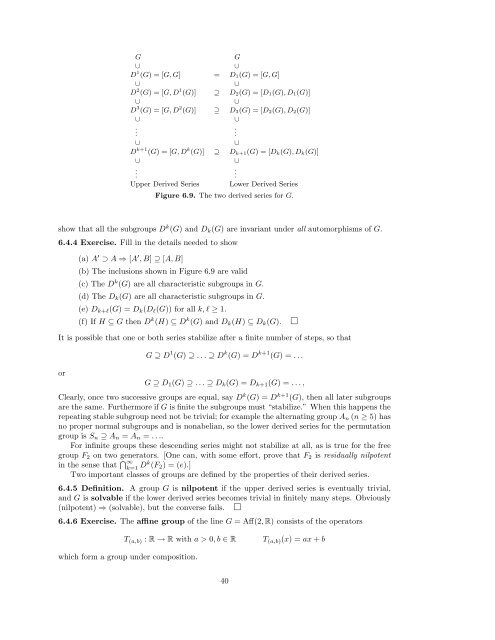Algebra I: Section 6. The structure of groups. 6.1 Direct products of ...
Algebra I: Section 6. The structure of groups. 6.1 Direct products of ...
Algebra I: Section 6. The structure of groups. 6.1 Direct products of ...
You also want an ePaper? Increase the reach of your titles
YUMPU automatically turns print PDFs into web optimized ePapers that Google loves.
G G<br />
∪ ∪<br />
D 1 (G) = [G, G] = D1(G) = [G, G]<br />
∪ ∪<br />
D 2 (G) = [G, D 1 (G)] ⊇ D2(G) = [D1(G), D1(G)]<br />
∪ ∪<br />
D 3 (G) = [G, D 2 (G)] ⊇ D3(G) = [D2(G), D2(G)]<br />
∪ ∪<br />
.<br />
.<br />
∪ ∪<br />
D k+1 (G) = [G, D k (G)] ⊇ Dk+1(G) = [Dk(G), Dk(G)]<br />
.<br />
∪ ∪<br />
.<br />
Upper Derived Series Lower Derived Series<br />
Figure <strong>6.</strong>9. <strong>The</strong> two derived series for G.<br />
show that all the sub<strong>groups</strong> D k (G) and Dk(G) are invariant under all automorphisms <strong>of</strong> G.<br />
<strong>6.</strong>4.4 Exercise. Fill in the details needed to show<br />
(a) A ′ ⊃ A ⇒ [A ′ , B] ⊇ [A, B]<br />
(b) <strong>The</strong> inclusions shown in Figure <strong>6.</strong>9 are valid<br />
(c) <strong>The</strong> D k (G) are all characteristic sub<strong>groups</strong> in G.<br />
(d) <strong>The</strong> Dk(G) are all characteristic sub<strong>groups</strong> in G.<br />
(e) Dk+ℓ(G) = Dk(Dℓ(G)) for all k, ℓ ≥ 1.<br />
(f) If H ⊆ G then D k (H) ⊆ D k (G) and Dk(H) ⊆ Dk(G). �<br />
It is possible that one or both series stabilize after a finite number <strong>of</strong> steps, so that<br />
or<br />
G ⊇ D 1 (G) ⊇ . . . ⊇ D k (G) = D k+1 (G) = . . .<br />
G ⊇ D1(G) ⊇ . . . ⊇ Dk(G) = Dk+1(G) = . . . ,<br />
Clearly, once two successive <strong>groups</strong> are equal, say Dk (G) = Dk+1 (G), then all later sub<strong>groups</strong><br />
are the same. Furthermore if G is finite the sub<strong>groups</strong> must “stabilize.” When this happens the<br />
repeating stable subgroup need not be trivial; for example the alternating group An (n ≥ 5) has<br />
no proper normal sub<strong>groups</strong> and is nonabelian, so the lower derived series for the permutation<br />
group is Sn ⊇ An = An = . . ..<br />
For infinite <strong>groups</strong> these descending series might not stabilize at all, as is true for the free<br />
group F2 on two generators. [One can, with some effort, prove that F2 is residually nilpotent<br />
in the sense that �∞ k=1 Dk (F2) = (e).]<br />
Two important classes <strong>of</strong> <strong>groups</strong> are defined by the properties <strong>of</strong> their derived series.<br />
<strong>6.</strong>4.5 Definition. A group G is nilpotent if the upper derived series is eventually trivial,<br />
and G is solvable if the lower derived series becomes trivial in finitely many steps. Obviously<br />
(nilpotent) ⇒ (solvable), but the converse fails. �<br />
<strong>6.</strong>4.6 Exercise. <strong>The</strong> affine group <strong>of</strong> the line G = Aff(2, R) consists <strong>of</strong> the operators<br />
T (a,b) : R → R with a > 0, b ∈ R T (a,b)(x) = ax + b<br />
which form a group under composition.<br />
40<br />
.

















